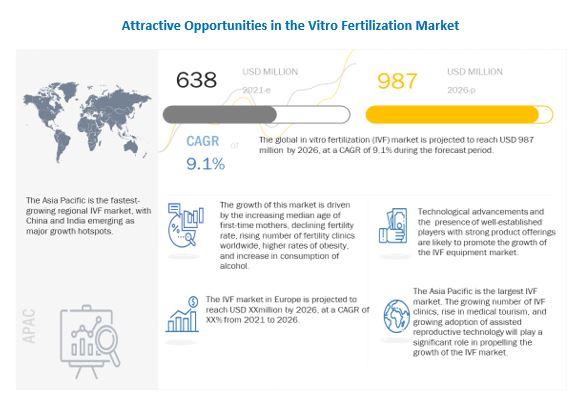According to new research study, "In Vitro Fertilization /IVF Market by Product (Micromanipulators, Incubators, Cabinets, Imaging System, Laser System, Reagents & Accessories), Type (Conventional IVF, IVF with ICSI), End User (Fertility Clinics, Hospitals, Cryobanks) - Global Forecast to 2026" The global in vitro fertilization market is projected to reach USD 987 million by 2026 from USD 638 million in 2021, at a CAGR of 9.1% from 2021 to 2026. The key factors fueling the growth of this market include an increase in the median age of first-time mothers, declining fertility rates, rising male infertility, rise in obesity rate and growing consumption of alcohol, and growing awareness about the availability of treatment options.
The spread of COVID-19 has not only impacted fertility clinics owing to the cancellation of IVF treatments but has also impacted fertility decisions among couples who had opted for IVF treatment before the pandemic.
With the median age for first-time mothers increasing, a growing number of women are expected to face difficulties in conceiving naturally. In this scenario, an increasing number of women are forced to opt for IVF treatments; this is expected to drive the growth of the IVF market in the coming years.
Download PDF Brochure @ https://www.marketsandmarkets.com/pdfdownloadNew.asp?id=89198891
More than 2.5 million vitro fertilization (IVF) cycles are performed every year worldwide. The cost of IVF treatment varies from country to country due to the lack of reimbursement policies. A lack of insurance coverage and the poor reimbursement scenario in some parts of the world are limiting the growth of this market.

The rise in number of IVF with ICSI procedure to support the market growth during the forecast period.
The success rate of fertilization with ICSI procedure and the growing utilization of the ICSI during IVF procedure are anticipated to boost the adoption of IVF with ICSI procedures, accelerating the growth of the segment during the forecast period. Moreover, the growing focus of players in expanding their product offerings in ICSI is anticipated to contribute towards the rapid adoption of IVF with ICSI procedures during the forecast period.
Expansion of healthcare infrastructure and increase in disposable personal income, rising medical tourism in Asian countries, increasing healthcare expenditure, and growing awareness among people about infertility are supporting the growth of the in vitro fertilization market in the region.
The high growth in this owes to the increasing number of IVF procedures and introduction of highly advanced IVF equipment by well-established manufacturers in the market.
The rising government initiatives to establish fertility clinics, initiatives taken by large international healthcare providers to establish fertility centers, growing popularity of IVF & ICSI treatment globally are some of the factors likely to contribute towards the rapid growth of the segment.
The fresh non-donor segment captured the largest share of the in vitro fertilization market cycles during the forecast period. High success rates, ease in the implantation process, and enhanced embryo production are responsible for the large share of this segment.
